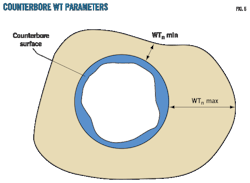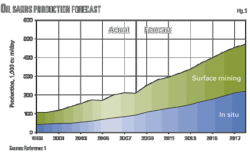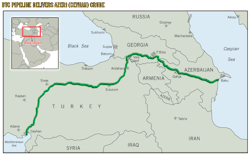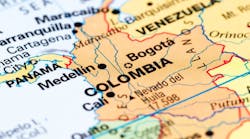This study is carried out for Dhulian and Khaur oil fields in Pakistan in the Potwar subbasin at the northern margin of the Indian Plate.
The area is characterized by thick infracambrian evaporates, a relatively thin stratigraphic section from Cambrian to Eocene time, and thick Miocene-Pliocene molasse deposits with extremely severe deformation during Himalayan orogeny in Pliocene to Middle Pleistocene.
The Potwar subbasin is structurally complex, and in some cases surface geological features do not reflect the subsurface structures. This study is carried out for the Paleogene reservoirs.
The top of Eocene is mapped, and then equal thicknesses from the nearby well are used to construct the Allen's diagram for one controversial fault to check the fault seal and presence of hydrocarbons on either side of the fault.
Allen's diagrams aid in analyzing fault juxtaposition and sealing. The diagrams are based on the interaction of rock lithology and the fault displacement (throw) magnitude to control juxtapositions that require mapping to identify compartments in hydrocarbon reservoirs and fault seal types. It is concluded that the traps on the downthrown side of the faults have great potential for the accumulation of hydrocarbons.
The majority of the reservoirs are sealing on the hanging wall. For Fault F1 the Patala and Nammal formations can be producing on the downthrown side. It is also interpreted that the production can be increased if a similar type of study were carried out for the Miocene Murree formation for the bounding faults.
Introduction
The typical traps in Dhulian and Khaur oil fields have been studied to analyze the fault seal (Fig. 1).
The work mainly focused on the analysis of 165 line-km of 2D seismic data along with well data from northern Pakistan. The region has undergone intense compression during late Pliocene, resulting in a complex fault-bounded trap condition.
Because of difficulties in acquisition and processing, uncertainty arises during the exploration phase to accurately interpret the trapping situation and fault sealing properties. These fields were discovered in 1936 and 1915, respectively. They have undergone much conventional seismic mapping and interpretation.
The goal is first to determine the reasons for the trap risks associated with the main and associated faults. The surrounding areas have been successfully drilled, with several hydrocarbon discoveries in Cenozoic and Mesozoic rocks.
An understanding of the probability of a fault acting as a differential migration barrier is critical for prospects that rely on a fault seal. The probability of a fault acting as a pressure barrier is important in field development and production where fault bounded compartments may not be in pressure communication because of sealing faults.1
Early work on fault seals concentrated on theoretical approaches.2 3 4 More work on the predictability of fault seals has been published.5 6 The main aim of this study is to analyze the fault seals that affect the hydrocarbon column, especially where reservoir is juxtaposed against reservoir.
Dhulian and Khaur
Dhulian oil field is 90 km southwest of Islamabad in the Central Potwar Plateau of the upper Indus basin.
Tectonically, this region forms part of an active foreland fold and thrust belt in northern Pakistan (Fig.1). The Dhulian structure was first mapped in 1877,7 and it was recognized as a likely oil-bearing prospect in 1914.8
The first commercial discovery of oil was made in Eocene limestone. Oil was also discovered in Indo-Pakistan from Paleocene and Jurassic reservoirs during further appraisal of the Dhulian structure. Some oil production was also obtained from the Miocene Murree formation during initial stages.
The Eocene reservoir at Dhulian field is almost depleted, but the Paleocene and Jurassic reservoirs have secondary recovery potential.
A total of 49 wells was drilled in Dhulian, and one of them went to a total depth of 7,863 ft in the Eocene Sakesar formation. Initially, the prospects for obtaining production below the Eocene were considered poor because of absence of oil shows in the Paleocene (Ranikot limestone).
An Eocene producing well was deepened to Ranikot and completed as an oil producer at a depth of 8,245 ft. The lighter Paleocene oil (43° gravity) had a much higher gas-oil ratio, and more Eocene wells were deepened to Ranikot, which gave satisfactory production.
Later a well was drilled to 9,106 ft, below the Eocene and Paleocene, and good production was obtained from coarse to medium-grained porous quartzose sandstones of the Datta formation ("variegated beds") of Jurassic age. The well was drilled to 12,428 ft to the Salt Range formation of Infracambrian age.
Khaur field, adjacent to Dhulian, is one of the earliest areas explored for hydrocarbons in the Indian subcontinent. The Khaur structure was explored in 1914 and proved to be the first commercial oil discovery in the South Asian subcontinent.
The producing formation is the fractured sandstone of the Murree formation. Since 1914, continued hydrocarbon exploration efforts proved the high prospectivity of the area. More than 400 wells were drilled in Khaur to various depths. The field has 30 oil reservoirs in the Murree sands and one in the Eocene limestone.9
Paleogene stratigraphy
The basic stratigraphy of the area, modified from the works of earlier authors,10-15 is shown in Fig. 2.
During Paleocene, shallow marine deposition ensued, which was dominated by bioclastic and micrite carbonates of the Lockhart limestone (Khairabad limestone).
The overlying Patala formation represents the alternation of deeper outer and shallower inner shelf facies. This is followed by another period of Paleocene carbonate buildup represented by Upper Ranikot and oyster beds, and this sedimentation was terminated with the onset of apparently more anoxic deepwater deposition of the Nammal formation.
During Eocene, shallow marine sedimentation resumed with deposition of a mainly calcareous-argillaceous sequence of the Sakesar and Chorgali formations. The overlying Kuldana formation, which consists of red claystones and shales, was deposited in open-marine to partially restricted environments.7
Paleogene play
Reservoir rock
Dhulian's initial production was obtained from a limestone of Eocene age near the contact of the Chorgali and Sakesar limestones. This oil-bearing horizon was remarkably consistent, and it became known as the "Main Oil Horizon."
The Eocene strata from the top of the Nammal formation to the base of the Kuldana formation are 475 ft thick in the central part of Dhulian field. The top 150-200 ft of this sequence overlies the "Main Oil Horizon," which has been described as chemical limestone.
Below this horizon, the limestone is coarse-grained and highly fossiliferous, but the lowest 150 ft of section consists of fine-grained compact limestone with no apparent permeability. However, high-salinity water flows have been encountered in this basal 150 ft section in the central part of the field.
The Paleocene reservoir may be divided into three stratigraphic units: oyster beds/Upper Ranikot, Patala formation, and Lockhart formation.
The oyster beds/Upper Ranikot limestone consists of 120 ft of argillaceous, highly fossiliferous limestone and forms the upper reservoir. This zone has produced oil from about seven wells.
The underlying Patala formation consists of an argillaceous foraminiferal limestone bounded by shales. This interval, the one termed "Patala Main limestone," is 60-70 ft thick.
The formation shows marked facies changes in the field limits. While the entire Patala formation consists of shale in one well, in some of the wells it is predominately limestone.
The formation generally thickens (75-150 ft) towards the east with a decrease in limestone-shale ratio. The Main Patala limestone has been productive in six of Dhulian's 49 wells.
The lowermost unit of the Paleocene section is the Lockhart formation (Khairabad limestone), a massive, argillaceous limestone. This zone has produced hydrocarbons from six wells in the same area.
Source and seal
The data regarding source rocks for Dhulian crude are not directly available to quantify the potential of each Paleocene and deeper rock unit and to locate the precise source rock.
However, Chorgali-Sakesar carbonates and shales along with Patala black marine shales are now considered potential source rocks. Data derived from nearby fields, where source rock studies were carried out, support this view.
The Kuldana formation consists of red and purple colored claystone and shale with occasional silty-sandy streaks. This formation is present all over Dhulian field and is 90-120 ft thick. The basal part of Kuldana is composed of green compact shales 10-20 ft thick. Due to its impermeable character, the Kuldana formation forms an effective seal over Dhulian's Eocene reservoir.
The Nammal formation consists of shales with thin argillaceous limestone bands. Shales of the Nammal formation (155-200 ft thick) are developed all over Dhulian field and provide the seal for the Ranikot reservoir.
Structural interpretation
A total of 13 seismic lines (9 dip lines and 4 strike lines) was used in this study.
Five dip lines passed over Dhulian field, and the other four dip lines cover the Khaur structure. One dip line (Fig. 3) and one strike line (Fig. 4) were mapped at Eocene top Chorgali formation of the Khaur structure, which shows two horizons (top Eocene in yellow and basement in red).
Intense faulting is observed on almost all the seismic lines in the overlying strata above the basement, whereas Precambrian basement shows that back thrusts juxtapose the Paleogene limestone across the Miocene shales, cap rock for the Eocene reservoirs. The time contour is converted into depth using well velocity control.
Fig. 5 shows the depth contour map over the prospect zone. It also reveals that both of the anticlines are cut through the apex by thrust faults, so we also need to check the seal along these fault planes. Other faults provide additional closure to the anticlines. As the anticlines are showing the four-way closures in the subsurface model, it can be interpreted as a "double plunging anticline" that dips opposite along the fold axis.
The Dhulian structure was originally thought to be a conventional anticline with a fold axis trending northeast-southwest. The multifold seismic indicates that the Dhulian subsurface structure is more complicated than originally thought.
Based on the seismic evidence, the Dhulian structure was proved to be a thrust-bounded, salt-cored anticline that is cut across by a major thrust fault that splits Dhulian into two major fault blocks.
The thrust and back thrust are found sealing on either side of the structure, and the clays of the Murree formation act as the seal along these faults. The fractured carbonates of the Chorgali formation and sands of the Murree formation are the major producing reservoirs in the Dhulian-Khaur area.
The fault that cuts across the Dhulian structure forms the southern fault block and the western fault block, thus creating two individual prospects favorable for oil accumulation. The fault that cuts the Khaur anticline only displaces the formation itself; however, it does not extend to the limit of the interpreted structural features.
The faults at the flanks of the anticlines are sealing as evident from throw. One fault that might not seal at different reservoir level is marked as F1 (Fig. 6), and we need to check it. One of the various methods available to check whether the fault acts as a seal is the Allen's diagram.
The advantages of Allen's diagrams is that they allow evaluation of a fault seal without the need for detailed three-dimensional mapping of stratigraphic horizons and fault planes and can be used to contour permeability, sealing capacity, and transmissibility of fault zones. These diagrams may be used to rapidly identify the critical fault throw and juxtapositions that require mapping to identify compartments in hydrocarbon reservoirs.
First by noting the upthrown and downthrown values on either sides of the fault F1 on the mapped horizon (Fig. 6), then by using the same scale for both axis (horizontal and vertical), these values are transferred on a graph for the upthrown and downthrown sides. The resulting diagram gives us the position of the same horizon in fault plane view but shows only the top of the mapped horizon.
The second thing we need is the well data of the nearest well to get the thicknesses of all the formations encountered in the well. The formation thicknesses are added on both the upthrown and downthrown sides to map the formations in fault plane view to check for the fault seal analysis (Figs. 7 and 8).
Fault seal analysis
The upthrown side of the Chorgali formation is juxtaposed against the shales at the base of the Murree formation, hence it acts as seal at the upthrown side.
The downthrown side of the Chorgali juxtaposes with the Sakesar formation, and both formations have the same limestone lithology and are reservoirs. Since the Sakesar is updip when juxtaposed with the Chorgali, there is no chance for hydrocarbons on the downthrown block at the Chorgali level. The juxtaposition of Chorgali and Sakesar is shown in Figs. 9 and 10.
The Sakesar formation at its downthrown side is juxtaposed with the upthrown side of the Nammal and Patala formations. The spill point exists at Nammal formation to Sakesar, and Sakesar also is juxtaposed with itself, hence there is no chance for hydrocarbons in the downthrown Sakesar, and the Chorgali and Sakesar can be productive on their upthrown sides. The Sakesar juxtaposition is shown in Fig. 11.
At the Nammal level, the upthrown side as discussed earlier juxtaposes the Sakesar formation, and hence the fault is not sealing at the Nammal upthrown side. While the downthrown side of the Nammal formation juxtaposes the basal shales of the Patala formation, we can say that the fault is sealing at the downthrown side of the Nammal formation. Figs. 12 and 13 show the Patala formation in juxtaposition with the Sakesar and Patala formations.
The Patala formation, too, produces in certain wells because its central unit, the one called "Patala Main limestone," is bounded by Patala shales on either side (top and base). In some of the wells, the entire Patala package consists of shale.
As discussed earlier, the limestone-shale ratio decreases and towards the east the entire package consists of shale in this region. In the upthrown side this section juxtaposes with the Sakesar formation on the downthrown side and also provides a seal for the Nammal formation on its downthrown side. On the downthrown side it juxtaposes the Lockhart formation and hence acts as a seal for the upthrown Lockhart, which is a massive limestone (Fig. 14).
The Lockhart formation is the last formation to be displaced by Fault F1, and this fault then dies out. The Lockhart formation is also sealing in the upthrown side, where it is juxtaposed with the Patala shales. There is a spill point from the downthrown side to the upthrown block of the same Lockhart formation (Fig. 15), hence Lockhart is not sealing in the downthrown side.
Finally, a typical cross-section view of the F1 Fault, shown in Fig. 16, does not give us the complete picture across the fault plane, especially where the throw of the faults varies along the fault (Fig. 17) as it is evident from the fault plane view and fault displacement at each point.
Results
Fault seal analysis discloses that the majority of the formations are good traps for hydrocarbons on the hanging wall side and that there are also chances for reserves on the foot wall.
As for Fault F1, the Nammal formation juxtaposes with the shales of the Patala and Lockhart formations and hence can be productive on the downthrown side. Similarly the reservoir part of the Patala formation, previously termed the "Patala Main limestone," juxtaposes with the shales of the Lockhart formation on the downthrown side and therefore acts as a good trap.
Major producing reservoirs in the Dhulian block are the Murree sands, and there are almost 40 Murree reservoir zones that are producing. These reservoirs consist of interbedded sand and shale sequences. If similar studies are carried out for the Murree formation for the bounding faults, the production can also be increased.
References
1. Knott, S.D., "Fault seal analysis in the North Sea," AAPG Bull., Vol. 77, 1993, pp. 778-792.
2. Smith, D.A., "Theoretical considerations of sealing and nonsealing faults," AAPG Bull., Vol. 50, 1996, pp. 363-374.
3. Downey, M.W., "Evaluating seals for hydrocarbon accumulations," AAPG Bull., Vol. 68, 1984, pp. 1,752-63.
4. Watts, N.L., "Theoretical aspects of cap-rock and fault seals for single and two phase hydrocarbon columns," Marine and Petroleum Geology, Vol. 4, 1987, pp. 274-307.
5. Allan, U.S., "Model for hydrocarbon migration and entrapment within faulted structures," AAPG Bull., Vol. 73, 1989, pp. 803-811.
6. Harding, T.P., and Tuminas, A.C., "Structural interpretation of hydrocarbon traps sealed by basement normal fault blocks at stable flank of foredeep basins and at rift basins," AAPG Bull., Vol. 73, 1989, pp. 812-840.
7. Hasany, S.T., and Farooq, A.K., "Dhulian Oil Field," Annual Technical Conference & Oil Show, 1998.
8. Gee, E.R., "Geology and petroleum prospects of the northern part of West Pakistan," Pakistan Petroleum Ltd. report, 1961.
9. Shami, B.A., Waqar, A.K.J., and Iftikhar, A.A., "Fracture analysis of Khaur anticline and its implications on subsurface fractures system," Annual Technical Conference & Oil Show, 2003.
10. "Pakistan petroleum prospects—An overview," Oil & Gas Development Corp., Islamabad, 1996, p. 22.
11. Quadri, Viqar-un-Nisa, and Quadri, S.M.G.J., "Anatomy of success in oil and gas exploration in Pakistan," OGJ, May 13, 1996, p. 92.
12. Kemal, A., "Geology and new trends for hydrocarbon exploration in Pakistan," in Ahmad, G., ed., "Proceedings of an international petroleum seminar on new directions and strategies for accelerating petroleum exploration and production in Pakistan," 1992.
13. Iqbal, M.W.A., and Shah, S.M.I., "A guide to the stratigraphy of Pakistan: Quetta, Geological Survey of Pakistan Records," Vol. 53, 1980.
14. Shah, S.M.I., Ahmed, R., Cheema, M.R., Fatmi, A.N., Iqbal, M.W.A., Raza, H.A., and Raza, S.M., "Stratigraphy of Pakistan," Geological Survey of Pakistan Memoirs, Vol. 12, 1977.
15. Wandrey, C.J., Law, B.E., and Haider, Ali Shah, "Patala-Nammal Composite Total Petroleum System, Kohat-Potwar Geologic Province, Pakistan," U.S. Geological Survey Bull. 2208-B, 2004.
The authors
M. Gulraiz Akhter ([email protected]) is an assistant professor in the Department of Earth Sciences at Quaid-i-Azam University. His areas of interest are exploration geophysics and numerical groundwater modeling. During his 20 years of experience, he has taught mathematics, geophysics techniques, and hydrogeology. He has a masters in geophysics and a PhD in hydrogeology from Quaid-i-Azam University.
Zulfiqar Ahmad is professor and chairman, Department of Earth Sciences, Quaid-i-Azam University. His work experience includes teaching, research, and administration. He has a PhD with specialization in numerical groundwater flow and solute transport computer modeling from the University of Kentucky, an MSc in hydrogeology from University College, and an MSc in geophysics with specialization in gravity prospecting from Quaid-i-Azam University.
Muhammad Zeeshan Munir is a geophysicist with Saif Energy Ltd. in Islamabad. He started his professional career with LMKR (Pakistan) in 2005 as system support analyst; providing Geographix system support and training to exploration and production companies in Pakistan. He joined Saif Energy in 2007 as a geophysicist. He has an MSc in geophysics and an MPhil Quaid-i-Azam University.
Azerbaijan
RWE Dea AG signed an agreement with State Oil Co. of the Azerbaijan Republic to explore the Nakhichevan block in the Caspian Sea off Azerbaijan.
Nakhichevan is 60 miles south of Baku (see map, OGJ, Nov. 20, 2000, p. 49). The German company said the agreement is "a first step towards RWE initiating upstream activities in Azerbaijan" and that it would gradually step up activities over time.
An Exxon affiliate explored a 100 sq mile block in the late 1990s over the "Nakhichevan prospective structure," formerly known as D-3, in 300-1,600 ft of water. It drilled one well in 2002 that didn't find hydrocarbons.
Northwest Territories
Paramount Resources Ltd., Calgary, plans to drill as many as eight operated oil wells in the Cameron Hills field area of Canada's Northwest Territories in 2010.
It expects to complete and tie in the first well in the first quarter. The rest are to be completed in the first quarter of 2010 and tied in during 2011. Production and follow-up development drilling associated with these wells will occur in later years, pending an evaluation of the 2010 drilling results (OGJ Online, Sept. 21, 2006).
The company's northern operating unit, which includes Cameron Hills, Fort Liard, and properties British Columbia and Alberta, had sales of 14.7 MMcfd of gas and 548 b/d of crude oil and natural gas liquids in 2009, down 21% from 2008 due mainly to natural declines and secondarily to the shut-in of properties. Capital spending was $8 million in 2009 excluding land.
Alaska
A subsidiary of Miller Petroleum Inc., Huntsville, Tenn., reworked and returned to production its West McArthur River Unit-5 well in Alaska's Cook Inlet at the rate of 557 b/d of oil and 131 Mcfd of gas from the Oligocene Hemlock formation.
Workover of the well, which last produced in December 2008 before a tubing failure, included adding new perforations below 13,000 ft in Hemlock bench 1-upper member (34 ft), which is the first time this member has been produced.
Miller plans to perforate in the same interval in WMRU-6, where a workover is in progress.
More Oil & Gas Journal Current Issue Articles
More Oil & Gas Journal Archives Issue Articles
View Oil and Gas Articles on PennEnergy.com







